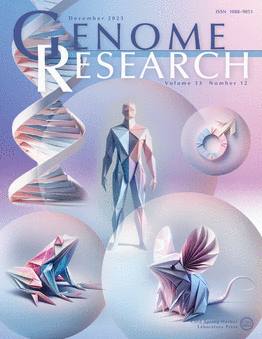再生改变了红系前体的开放染色质和顺式调控景观
IF 5.5
2区 生物学
Q1 BIOCHEMISTRY & MOLECULAR BIOLOGY
引用次数: 0
摘要
应激性红细胞生成是对应激源(如贫血或缺氧)的生理反应,可提高红细胞(RBC)生成率。在急性贫血中,红细胞祖细胞和前体暂时重新连接它们的转录组,上调和下调数百个基因,以加速成熟红细胞的产生。有效的再生需要关键细胞因子信号(如BMP4)和染色质上协调转录变化的顺式调控元件之间的沟通。为了确定贫血特异性基因表达和细胞反应背后的顺式调控变化,我们分析了在贫血诱导后不同时间点从小鼠分离的红细胞前体富集细胞群的染色质可及性。在贫血反应早期,染色质在含有ap -1的区域短暂开放,与Jun和Fos转录物/蛋白水平升高相关。体外敲除Jun可降低贫血诱导后KIT+红细胞前体的百分比。我们观察到在与贫血消退一致的时间点上发生了第二次重新布线事件,涉及GATA因子可及区域的抑制和ETS因子可及区域的激活。在小鼠体内模型和受BMP4刺激的人CD34+细胞中,可及性在先前与人血液表型相关的区域发生变化。许多BMP4和贫血激活位点对自然的人类变异很敏感。在贫血消退后1个多月,ATAC-seq数据中红细胞性状相关位点的代表性持续升高。总之,这些发现为理解红细胞前体中再生依赖性转录组的早期建立和晚期解析提供了一个框架。本文章由计算机程序翻译,如有差异,请以英文原文为准。
Regeneration alters open chromatin and cis-regulatory landscape of erythroid precursors
Stress erythropoiesis elevates the rate of red blood cell (RBC) production as a physiological response to stressors such as anemia or hypoxia. In acute anemia, RBC progenitors and precursors temporarily rewire their transcriptome, up- and downregulating hundreds of genes to accelerate the production of mature RBCs. Effective regeneration requires communication between critical cytokine signals (e.g., BMP4) and cis-regulatory elements on chromatin which coordinate transcriptional changes. To identify cis-regulatory changes that underlie anemia-specific gene expression and cellular responses, we analyzed chromatin accessibility in populations of cells enriched for red blood cell precursors isolated from mice at a range of time points after anemia induction. Early in the anemia response, chromatin is transiently open at AP-1-containing regions, correlated with increased Jun and Fos transcript/protein levels. Jun knockdown ex vivo decreases the percentage of KIT+ erythroid precursors after anemia induction. We observe a second rewiring event at time points consistent with anemia resolution, involving repression of GATA factor-accessible regions and activation of ETS factor-accessible regions. In both mouse in vivo models and human CD34+ cells stimulated with BMP4, accessibility changes at regions with prior associations to human blood phenotypes. Dozens of BMP4- and anemia-activated loci are sensitive to natural human variation. The representation of red blood cell trait–associated loci in ATAC-seq data remains durably elevated more than 1 month after anemia resolution. Together, these findings provide a framework to understand the early establishment and late resolution of a regeneration-dependent transcriptome in RBC precursors.
求助全文
通过发布文献求助,成功后即可免费获取论文全文。
去求助
来源期刊

Genome research
生物-生化与分子生物学
CiteScore
12.40
自引率
1.40%
发文量
140
审稿时长
6 months
期刊介绍:
Launched in 1995, Genome Research is an international, continuously published, peer-reviewed journal that focuses on research that provides novel insights into the genome biology of all organisms, including advances in genomic medicine.
Among the topics considered by the journal are genome structure and function, comparative genomics, molecular evolution, genome-scale quantitative and population genetics, proteomics, epigenomics, and systems biology. The journal also features exciting gene discoveries and reports of cutting-edge computational biology and high-throughput methodologies.
New data in these areas are published as research papers, or methods and resource reports that provide novel information on technologies or tools that will be of interest to a broad readership. Complete data sets are presented electronically on the journal''s web site where appropriate. The journal also provides Reviews, Perspectives, and Insight/Outlook articles, which present commentary on the latest advances published both here and elsewhere, placing such progress in its broader biological context.
 求助内容:
求助内容: 应助结果提醒方式:
应助结果提醒方式:


